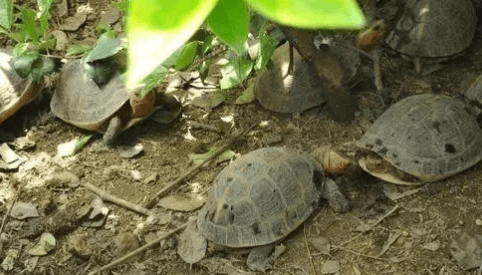We usually say not to mix the turtles at will, because mixed breeding is prone to conflicts and the turtles will be harmed. Therefore, we all emphasize that when mixed breeding, there should be little individual differences, little difference in habits, and the breeding space should be large. This can reduce the "fighting" of turtles.
In fact, during our breeding process, it is relatively rare for one to be raised alone. Most of the time, several are raised together, which is more lively and lively. Not to mention whether they are mixed-breeding, even if they are of the same species, I believe that few people keep one alone, and most of them have two or more.
So, have you ever encountered turtles hurting each other and biting each other’s tails? Sometimes it is really bloody and dyes the water red.

The first one: Place pebbles in the pond where turtles are raised
< p> You can try placing some pebbles in the breeding pond. Many farmers may not know the role of these pebbles. In fact, when the turtle touches the pebbles, its tail will retract directly into the shell, naturally. This can reduce the chance of tail biting.Second: Reduce the light environment for turtles to survive
The requirements for the light environment for turtles to survive are actually not very high. They basically prefer a darker environment because it is too Strong light will make the turtles feel insecure. They will be in a state of tension for a long time and their temper will be relatively irritable. In this way, the turtles will easily fight with each other and tail biting will increase. Therefore, when we breed, we can appropriately place the breeding environment in a lower light. If it is outdoors, we can add some shading measures, which can prevent turtles from suffering from heat stroke in summer and also reduce the risk of turtles suffering from heatstroke. Turtle tail biting.
Third: Regularly disinfect the breeding environment of turtles
Some senior farmers said that turtle hatchlings are prone to tail biting because of bacterial infection. Sometimes this may happen to a pool of turtle hatchlings, but after the breeding environment is disinfected, the tail biting situation is significantly reduced. Although the editor currently has no specific scientific certification for this conclusion, you can still keep it in mind. If a large area of tail biting occurs, you might as well try this method.

Fourth: Using muddy water for breeding
We all We know that when breeding turtles, the water quality of turtles is very important. The water quality needs to be clean, so many farmers think that the water quality of muddy water is not suitable for raising turtles. In fact, everyone has been misled because of the water quality. Clean does not mean the transparency of water, and muddy water does not mean dirty water. Therefore, for some more ferocious turtles, such as snapping turtles, eagle-billed turtles, etc., they can be cultured in muddy water such as yellow mud water to reduce the transparency of the water and reduce the occurrence of tail biting by turtles.
Another reason is the turtle’s character. This is the editor’s personal experience. I wonder if all turtle friends agree? The editor has a tortoise with a personality that may be a bit flawed. He likes to bully others of his kind, most likely by biting other people's tails. If you encounter a weak person, you will always bully it. If you encounter a strong person, you will confront it, and you will be much better behaved. Is this called wanting a beating? Now I am raising it with a strong one.
If there is mutual harm or tail biting, we should actively find the cause and put an end to it. After all, turtles will not just bite the tails, toes, etc. of their companions. We also actively treat the situation when it occurs, and disinfect and dry the animals when they need to be cured.

 扫一扫微信交流
扫一扫微信交流
发布评论